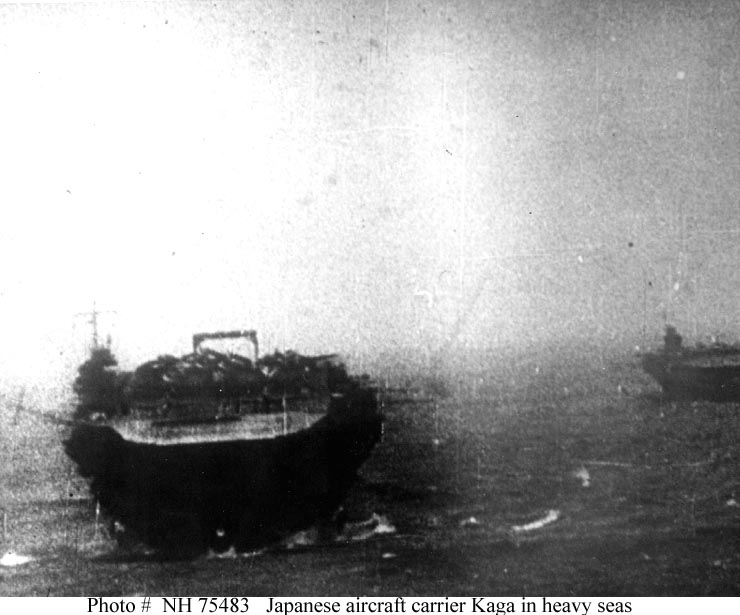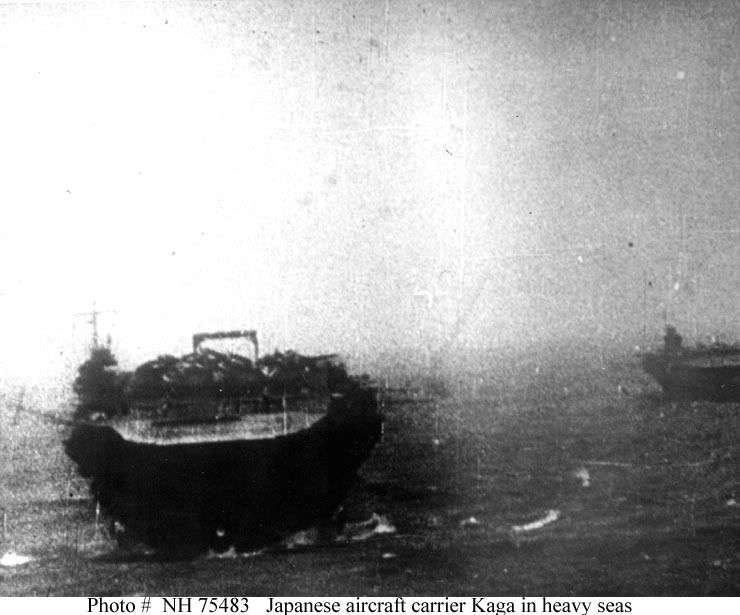This has always puzzled me; just what is the spoiler looking object spanning the flight deck?

This has always puzzled me; just what is the spoiler looking object spanning the flight deck?

I can’t see the picture, but if it is what I think you are referring to, then it is a windbreak to shield the deck when the ship is steaming into the wind.
Hey there Chuck, this is the familiar picture of the Kaga and one of her sister ships enroute to the attack on Pearl Harbor. It shows the ships head on in heavy seas. On the flight deck, in what seems to be the middle of the aircraft, is what seems to be a large gantry crane spanning several of the planes. I always thought it looked like the wing on the back of a Plymouth Superbird or Dodge Daytona. It might be a crane but I cannot be sure. It might even be over the forward centerline aircraft elevator. It seems very high compared to the island structure on the starboard side. Also note the tilted mast to the left.
Is this the picture in question?

I know the masts swung away from the flight deck for launching operations, but I have no idea what that structure is. Not even sure if it’s part of the Kaga or possibly a ship located behind her - possibly the superstructure of a tender or oiler?
All I got on your post was the dreaded red “X”. But the description you give seems to be describing the same photo. After a search on the web, I could find no reference to the structure or the angled mast on the forward starboard bow either. I know that on modern CVs, the antennae are lowered to the horizontal for flight ops. These two ships don’t seem to be in a flight op status and are apparently in a transit mode. ??? In all the drawings and photos that I have been able to view, there hasn’t been any showing a forward mast or antenna of any kind.
Just an afterthought, the IJN would perform their underway replenishments with the ships in trailing positions. Did the task force refuel prior to the Pearl Harbor attack? Maybe the CV was refueling an escort or perhaps dragging a refueling line to an oiler for a sip of oil.
If I remember correctly, the Japanese fleet did perform a final refueling just prior to making the run to the final launch point (roughly a day prior to the attack). The oilers then left the fleet. I don’t know if they rejoined the fleet after the attack or returned to Japan.
It can’t be an oiler because of of the lack of masts and funnels and it’s exactly parallel with the carrier’s deck, unlikely if it was another ship in those seas.
That structure is most likely the stern deck elevator. Apparently, instead of lowering to the hangar as is conventional to pick up aircraft, the elevator is a box structure the top of which is flush with the deck normally. The whole thing rises to bring aircraft to the upper deck taking the deck surface up instead of down.
Here’s a model pic of Kaga which shows it in the raised position;
www.h3.dion.ne.jp/~mokei/image/kaga-up.jpg
Michael
At the risk of making absolutely no point at all…
I’m no seafaring man (disclaimer), but there are a few things about that photo that make me doubt that the seas are so very heavy. First of all, I wouldn’t think they would keep their aircraft on deck if the ocean was rough, as that would increase the chance of losing one or more either overboard or to damage. Second, the antennas are swung out/down as if for flight operations - on both counts that makes no sense in heavy seas. And I had briefly wondered if that was how the elevator was designed, but figured if it were, it would be too topheavy when raised, since the upper surface would have to be sturdy enough to handle landings. And regardless, I think it would be an absolutely horrible idea to have the elevator raised like that in heavy seas - just think of how easily it could be damaged by violent motion of the ship. And finally, I really don’t see much in the way of waves or troughs - the water seems to be relatively flat; the darkness of the photo gives the illusion of stormy conditions, but nothing I see in the photo gives any indication that this is the case. There’s fog somewhat obscuring the other ship, but we know there was rain and fog en route to Pearl. That would account for the fog and the lack of sunlight in the photo.
As far as the antennas are concerned, I can’t recall where, but I remember seeing at least one Japanese carrier with antennas that would swing out & down for flight operations, and that’s clearly the case here - the one slightly raised on the left as well as the two completely lowered on the right.
There - that’s my story, and I’m sticking to it. Unless I’m wrong - in which case I was just kidding.
By the Lord Harry, and here’s me thinking the the subject was the structure on the Kaga’s deck! [;)]
You’re quite right old boy, and I bow to your superior observational skills. The point is, as you suggest, totally irrelevant however. I said “those seas” and even if “those seas” are calm by your estimation, they are sufficient to expect any two ships to be rolling at different angles at any given moment, what?
The elevator structure is no doubt forced by a lack of room in the stern of the converted ship and certainly would not be a matter of preference.[yuck]
Incidentally, this would have to be the ugliest vessel I have ever seen, by jingo.
Michael
The structure in question is the aircraft elevator. The top of the elevator was actually the flight-deck, with a hangar deck level below (unlike US carriers). When the hangar was raised to the flight deck an extension protruded above the deck level.
It makes sense to me, thanks for clearing this one up for me. I think that this photo is taken from Japanese newsreel footage taken just prior to launching the aircraft for the attack. It looks like the planes in front are spinning props. The tilted mast just might be farther aft than it appears in the picture.
That’s exactly what I said[^]. Her other elevators appear to be conventional however so I’d be interested to know whether this was brought about by necessity or for experimental purposes, most likely the former I’d guess.
Michael
Based on Norm Polmar’s book on US carriers, it was the US practice to store its aircraft on the flightdeck and use the hangar for maintenance. They also suspended extra aircraft from the ceiling on the hangar deck.
The hangar decks had catapults to launch aircraft out the side openings.
Steve
Which ships had these catapults??
All the Essex class carriers had third hanger catapault to launch aircraft out of side of the hanger. These were seldom, if ever, used however.
I was stationed on the Lexington (CVT-16) from 1975-1976 and never heard of any rumors or saw any evidence of where they were installed. I know they must have been removed way before I was on her but I am still surprised to hear of their existence. Learn something new everyday.
Actually, a small clarification is needed here. There were actually two sub-classes of the Essex class. They were divided into “short” hull, and “long” hull designs. While all are generally refered to as “Essex” class, only the short hull models were true Essex class as designed. The long hull versions were unofficially refered to as “Ticonderoga” class, but you wont be wrong calling them Essex class.
CV-9 through -13, -16 through -18, -20, -31, were short hull version.
CV-14, -15, -19, -21, -32, -33 through -40, -45, -46, and -47 were long hull version. The hulls were 68 feet longer than the short hull.
Only early-built short hulls recieved the hangar deck catapult, and in March 1943 all were removed in favor of a second flight deck installation.
And now back to our original story, about the IJN Kaga.[:I], yeah, that’s the elevator in the photo.
You’re all wrong! Can’t anyone else see the ideographs that spell out “Eat at Joes”? We are looking at one of the earliest known examples of a seagoing billboard.
[(-D] Yeah, thanks I had a mouth full of tea when I read that.[(-D]
Actually, it might have said “Eat at Hirohito’s”.
I got to looking at my last post, and some might think, “there’s holes in the numbers for the Essex class hull numbers.”
That’s because two other classes overlapped with the Essex class in order of construction. After CV-21 Boxer, the next 9 numbers (22 through 30) went to “Independence” class light carriers. CV-41,-42, and -43 were the Midways. CV-44 was never laid down.
Thanks for letting me bore you.